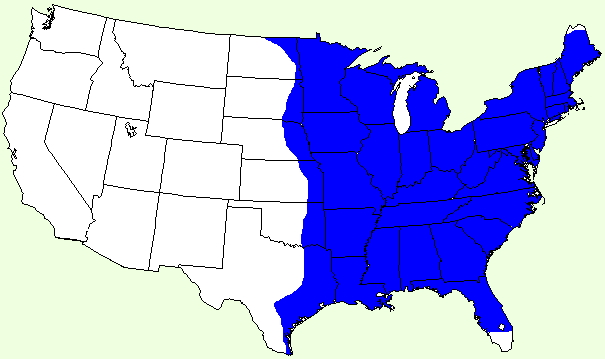

Descriptive Qualities:
Range: The luna moth is found in the whole eastern half of the U.S. from mid-Texas north to Montana and then east to Florida and Maine.
Map of this moth's Area:

Eggs and Larva
The female Luna moth carries,
depending on size of
particular moth, approximately 200 - 250 eggs. Luna moth caterpillars look almost the same
throughout all their instars. In 1st instar the larva
have black stripes on their sides, but it is usually back to solid green by 2nd instar.
They remain solid green for the rest of their instars, with little change to anything else. However, their head turns brown in 4th/5th instar.
Scenting and Mating
Female Luna moths usually put their scent out between 1:00 A.M. and dawn. Males may come in at
any time during that period. It is easiest to put the female in a metal cage with holes big
enough that they can mate through it (about a half inch or 3/4 inch hole should do nicely) but
small enough that the female cannot escape. That is one way to do it, but I usually stay up and
wait for the males to come in, and then put them with the female. This way is the only real way
to tell how many came in. Luna moths mate readily in captivity.
Cocoons
Luna moth caterpillars usually make
their cocoons only on leaves (not attached to any twigs) which drop to the ground, which is one
reason they aren't as common as other silk moths in suburban areas; they are raked up with
leaves and disposed of or burned. Lunas have 2 broods in most of their area. With one brood in the far north of the range and 3 to 4 broods in the southern part of their range.
Personal Markings or Characteristics
One obvious way to tell the luna moth from other silk moths is their green color. Their tails are another obvious way. Lunas of the first brood often
have a purple stripe on both sides of their bodies. This is due to a build-up of pigment in the winter months. Aside from the antennae, another way to differentiate between male and female lunas is that female's wings usually appear to be more transparent than the male's. The male's wings are
powdery green and white, but the female's look almost see-through.
Caring For Lunas, In All Stages:
Here are some notes that may be helpful when trying to raise Luna caterpillars, especially if it's your first time raising them.Caring for the eggs
To care for Luna eggs, just put them in a small container. It is best to be small, because the caterpillars like to crawl a lot when they first hatch, and if you put them in a bigger container, they will crawl away from the food you put in with them, and might not be able to get back. That's a lot of area for such a small caterpillar.
Food Plants
Here is a list of all food plants that I have ever used to raise Lunas on. In the odd occurance that you can not come by any of these, you should contact me. Experimenting with other foodplants could prove worthwhile.
Raising the Larva (Inside)
Luna larva are fairly easy to raise inside. I find it is easiest and beneficial to have them in a cottage cheese size container until about 2nd or 3rd instar, and then I move them to a ice cream bucket or a five gallon bucket for their last few instars.
Raising the Larva (Outside)
Luna larva are very easy to raise outside. You just find a suitable host plant and put the larva on it. It is best to put them on a branch and then put the branch inside some sort of netting, so that they are protected from predators like insects, birds, and rodents. For more information see Predators
Caring for the cocoons
Caring for the cocoons is pretty simple. You should put them in an area where it is fairly moist, if the cocoons dry out, they will die. If you just put them outside they should be fine. You cannot leave them inside, because they will hatch, but you can keep them in the refridgerator. If you do this, it is best to spray the cocoons with a light mist every once in a while so they don't dry out.
Return to Index.